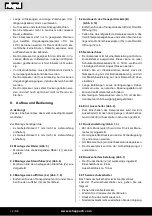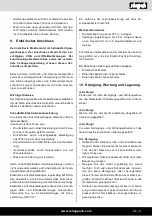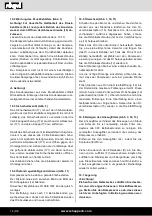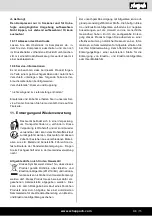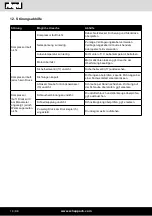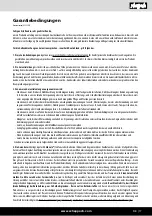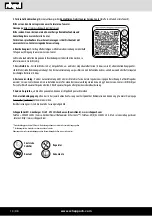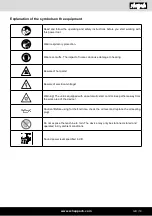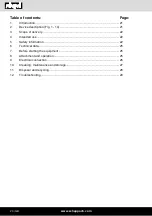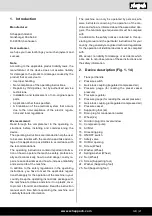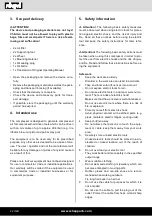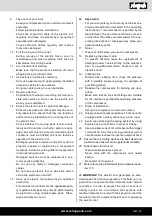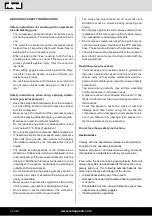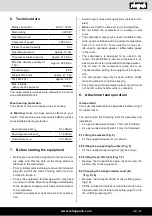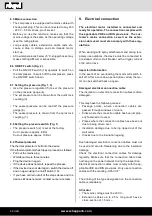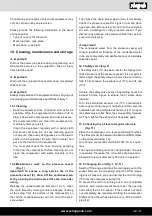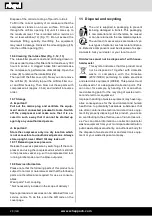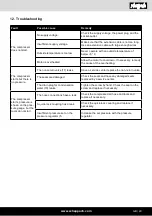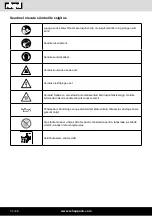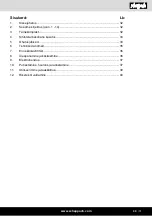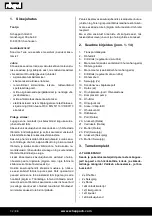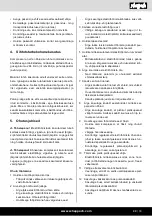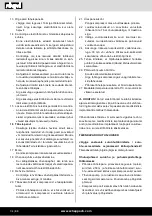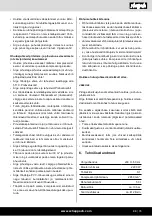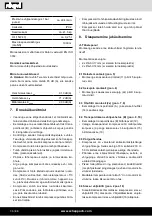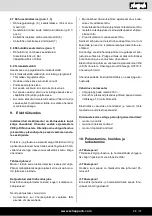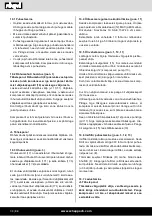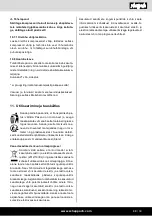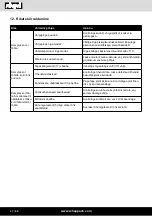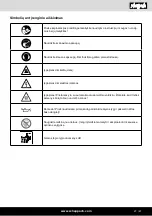
www.scheppach.com
26 | GB
9. Electrical connection
The electrical motor installed is connected and
ready for operation. The connection complies with
the applicable VDE and DIN provisions. The cus-
tomer‘s mains connection as well as the exten-
sion cable used must also comply with these reg-
ulations.
When working with spray attachments and during tem-
porary use outdoors, the device must be connected to
a residual current circuit breaker with a trigger current
of 30 mA or less.
Important information
In the event of an overloading the motor will switch it-
self off. After a cool-down period (time varies) the mo-
tor can be switched back on again.
Damaged electrical connection cable
The insulation on electrical connection cables is often
damaged.
This may have the following causes:
• Passage points, where connection cables are
passed through windows or doors.
• Kinks where the connection cable has been improp-
erly fastened or routed.
• Places where the connection cables have been cut
due to being driven over.
• Insulation damage due to being ripped out of the
wall outlet.
• Cracks due to the insulation ageing.
Such damaged electrical connection cables must not
be used and are life-threatening due to the insulation
damage.
Check the electrical connection cables for damage
regularly. Make sure that the connection cable does
not hang on the power network during the inspection.
Electrical connection cables must comply with the ap-
plicable VDE and DIN provisions. Only use connection
cables with the marking „H05VV-F“.
The printing of the type designation on the connection
cable is mandatory.
AC motor
• The mains voltage must be 230 V~
• Extension cables up to 25 m long must have a
cross-section of 1.5 mm
2
.
8.5 Mains connection
• The compressor is equipped with a mains cable with
shock-proof plug. This can be connected to any 230
- 240 V~ 50 Hz shock-proof socket.
• Before you use the machine, make sure that the
mains voltage is the same as the operating voltage
(see the rating plate).
• Long supply cables, extensions, cable reels etc.
cause a drop in voltage and can impede motor
start-up.
• At low temperatures below +5°C, sluggishness may
make starting difficult or impossible.
8.6 ON/OFF switch (Fig. 2)
• Pull the ON/OFF switch (16) upwards to switch on
the compressor. To switch off the compressor, press
the ON/OFF switch down.
8.7 Setting the pressure (Fig. 1, 3)
• Use the pressure regulator (5) to set the pressure
on the pressure gauge (4).
• The set pressure can be drawn from the quick lock
coupling (3).
• The vessel pressure can be read off the pressure
gauge (6).
• The vessel pressure is drawn from the quick lock
coupling (7).
8.8 Setting the pressure switch (Fig. 1)
• The pressure switch (2) is set at the factory.
Cut in pressure approx. 8 Bar
Cut-out pressure approx. 10 Bar.
8.9 Thermal protector
The thermal protector is built into the device.
If the thermal protector has tripped, proceed as follows:
• Pull out the mains plug.
• Wait about two to three minutes.
• Plug the device in again.
• If the device does not start, repeat the process.
• If the device does not start again, switch the device off
and on again using the on/off switch (16).
• If you have carried out all of the steps above and the
device still does not work, contact our service team.
Summary of Contents for 5906102901
Page 4: ...www scheppach com 4 15 19 m i n m a x 12 10 11 C D E G C D E F 12 13...
Page 96: ...www scheppach com 96...
Page 97: ...www scheppach com 97...
Page 98: ...www scheppach com 98...

